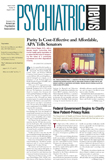APA’s 12th practice guideline—and its first for the treatment of patients with borderline personality disorder—was approved by the APA Board of Trustees at its June 29-July 1 meeting in Annapolis, Md.
This is “marvelous, big news, a really great thing for the field,” John McIntyre, M.D., the chair of APA’s Steering Committee on Practice Guidelines and a former APA president, told Psychiatric News. “Since this is traditionally recognized to be a difficult disorder to treat, with some special issues for clinicians, I think it will be one of the best-received, most helpful guidelines.”
Although a practice guideline on borderline personality disorder had been part of the overall practice guideline master plan when it was launched a decade ago, the Steering Committee on Practice Guidelines decided it would start designing guidelines for the Axis I disorders first. The reason, McIntyre explained, is that there was a strong research database for the Axis I disorders, which was not the case at the time for borderline personality disorder. But as the years went by, data on borderline personality disorder began to accumulate. Also, the steering committee started to get feedback from APA members that there was an urgent need for a guideline on borderline personality disorder. So the steering committee decided that the time had come to tackle it, McIntyre said, and the work group got under way in 1999.
Not surprisingly, the work group faced some special challenges in putting the guideline together. For instance, as McIntyre pointed out, “There were a lot of important issues in terms of the doctor-patient relationship that needed special attention in the guideline and that had to be carefully formulated.”
“There were two things that we had to struggle with a lot,” said John Oldham, M.D., the chair of the work group on borderline personality disorder. “One was to work out a way to review the voluminous clinical material and come to a consensus about recommendations that were derived from a combination of the existing but somewhat limited controlled trials and of the case study-clinical treatment literature. The other thing is that, although it is true for a number of other conditions, there is quite a bit of comorbidity between Axis I and Axis II for people with borderline personality disorder. So we had to think about that and address that and kind of cross-reference the existing guidelines for coexisting conditions.”
At the same time, though, the work group got enormous help from various sources in meeting the challenges of putting the guideline together. For instance, as McIntyre pointed out, APA’s Commission on Psychotherapy by Psychiatrists was extremely supportive.
“We presented workshops at every APA meeting once we convened as a work group and also at the Institute on Psychiatric Services,” Oldham said. “We had packed houses at every single one of them because people were so interested in this subject. And we got a lot of good feedback from audience participation that led to ideas that shaped the guideline in many ways—for instance, the extensive section on risk management.”
Once the work group completed a guideline draft, the draft received input from numerous reviewers. A much-revised draft was then presented to the APA Assembly last May. It was approved after some additional changes. A special work group set up by the Assembly and the APA Board of Trustees then met with the guideline work group and made still more changes in the guideline. This version was submitted to the Board on June 30 and was approved, thus becoming APA’s 12th official practice guideline. Altogether some 600 clinicians and scientists, plus reviewers, had been involved in the guideline from start to finish.
The borderline personality disorder guideline will be published as a supplement to the October issue of the American Journal of Psychiatry. It will also be published as a monograph available for sale from American Psychiatric Publishing Inc. It will likewise be included in APPI’s next compendium of practice guidelines. ▪
